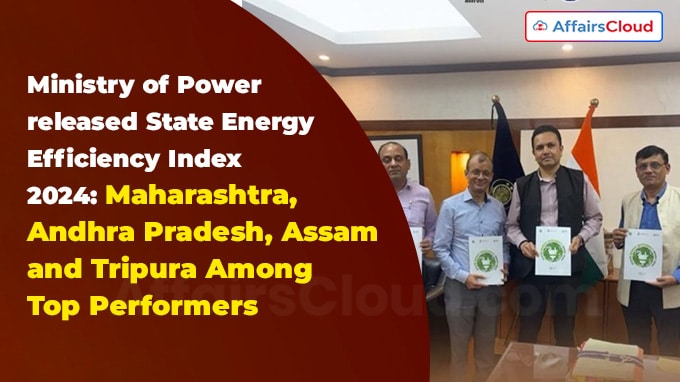
On 29 August 2025, the Ministry of Power (MoP) released the sixth edition of the State Energy Efficiency Index for fiscal year 2023-24 (SEEI 2024) to assess and track the progress of states in managing and improving energy efficiency.
- The index has been prepared by the Bureau of Energy Efficiency (BEE) together with the Alliance for an Energy Efficient Economy (AEEE). It was released by Akash Tripathi, who is the Additional Secretary in the MoP and also the Director General (DG) of BEE.
- According to the index, the top performing states are Maharashtra, Andhra Pradesh (AP), Assam, and Tripura for their respective group.
Exam Hints:
- Event: MoP Releases 6th Edition of State Energy Efficiency Index 2024
- Prepared by: BEE with AEEE
Top Performer: Maharashtra, Andhra Pradesh (AP), Assam, and Tripura
Categories: Front Runners (above 60%), Achievers (50–60%), Contenders (30–50%), and Aspirants (below 30%). - Groups:
- Group 1: >15 MToE (Million Tonnes of Oil Equivalent)
- Group 2: 5–15 MToE
- Group 3: 1–5 MToE
- Group 4: <1 MToE
About State Energy Efficiency Index (SEEI) 2024):
The SEEI 2024 reviews how 36 States and Union Territories (UTs) performed in energy efficiency during the financial year 203-24 (FY 24).The index promotes healthy competition, highlights best practices, and encourages states to take stronger steps towards saving energy.
Indicators: This edition uses a stronger, implementation-based framework with 66 indicators covering seven important sectors—buildings, industry, municipal services, transport, agriculture, power distribution companies (DISCOMS), and cross-sector programmes
Categories: The states are grouped into four categories based on their performance:
- Front Runners (above 60%),
- Achievers (50–60%),
- Contenders (30–50%), and
- Aspirants (below 30%).
Groups Based on TFEC: States and Union Territories (UTs) are divided into four groups based on their Total Final Energy Consumption (TFEC):
- Group 1: >15 MToE (Million Tonnes of Oil Equivalent)
- Group 2: 5–15 MToE
- Group 3: 1–5 MToE
- Group 4: <1 MToE
Top Performing States by Energy Consumption Group
| Energy Consumption Group | Top Performers |
|---|---|
| Group 1 | Maharashtra |
| Group 2 | Andhra Pradesh (AP) |
| Group 3 | Assam |
| Group 4 | Tripura |
Note: Maharashtra and Andhra Pradesh scored 80.5% and 79.3%, respectively
Top Performers: Maharashtra has emerged as the leader among Group 1 states with energy use above 15 MToE. Andhra Pradesh led Group 2 (5–15 MToE), Assam came first in Group 3 (1–5 MToE), and Tripura topped Group 4 ( <1 MToE).
Front Runner States: The 2024 index shows some changes compared to 2023. The number of Front Runner states has reduced from seven to five, with AP, Karnataka, Maharashtra, Telangana, and Tamil Nadu (TN) still holding this position.
Achievers and Contenders: Assam and Kerala have been placed in the Achievers category, while Haryana, Punjab, Rajasthan, Odisha, and Uttar Pradesh (UP) are identified as Contenders.
Key Sectoral Progress:
Progress has also been recorded across different sectors.
Buildings Sector: In the buildings sector, 24 states have put the Energy Conservation Building Code (ECBC) 2017 into place, and 20 states have linked it with their municipal by-laws.
Industrial Sector: For the industrial sector, 10 states have policies to support energy efficiency in Micro, Small and Medium Enterprises (MSMEs), and seven require energy audits in industries that are not covered under the PAT (Perform, Achieve and Trade) scheme.
Municipal and Transport Sector: In the municipal sector, 25 states have prepared Climate or Heat Action Plans, and 12 report joint work between state agencies and local urban bodies.
- In transport, 31 states now have electric mobility policies, and 14 states have made Electric Vehicle (EV) charging facilities mandatory in new buildings.
Agriculture Sector: In agriculture, 13 states are promoting cold storage facilities and solar-powered pumps, with Kerala leading the way by achieving 74% adoption of efficient or solar pumps.
Note: These efforts support India’s climate goals of cutting emission intensity by 45% by 2030 and achieving net-zero by 2070.




